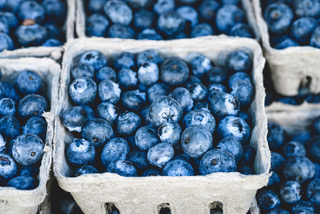In the age of Keto and Low Carb, fruit is under fire for its high sugar content compared to other whole foods. With all the bad press, you may be wondering if fruit still has a place in a healthy diet, or whether it should be kicked to the curb alongside processed, sugary foods and beverages.
What’s all the fuss?
Like vegetables, fruit is loaded body loving vitamins, minerals, phytonutrients, and water, and can be a great way to satisfy a sweet tooth, without turning to cake, cookies, and other sugary treats. It’s also jam packed with fiber which is great for your gut, digestive health and weight management goals.
But, fruits are also rich in carbohydrates, and herein lies the controversy.
When consumed, fruit is broken down in the body into two simple sugars, glucose and fructose.
Glucose is delivered to your muscles, brain, and other organs for energy use, while fructose is sent off to the liver where it is metabolized; and the excess is repackaged and stored as fat. This process can lead to a slew of health issues, including higher blood lipid (cholesterol and triglycerides) levels, increased belly fat, and elevated uric acid which is associated with high blood pressure and gout. In excess, fructose can also trigger sugar cravings, leading to an overconsumption of carbohydrate rich foods, spikes in blood sugar, weight gain, and systemic inflammation.
Luckily whole fruit comes naturally packaged with fiber and water, and takes time to digest and break down in our body. Unlike processed, sugar laden foods and beverages that hit the blood stream fast and deliver rapid, unnaturally high levels of fructose straight to our liver, wreaking havoc with our health, our bodies know how to deal with the slower release of fructose that comes from consuming whole, fresh fruit. The fiber in fruit also makes you feel full faster than if you consumed overly processed, sugary foods without fiber, making it a lot harder to overindulge on whole, fresh fruit. I mean, really, how many apples can a person eat in one sitting?
That said, fruit doesn’t get a total green light. For weight management and overall health, fruit is best consumed mindfully, and in ways that won’t spike blood sugar, trigger cravings or set you up for weight gain. Learning how to incorporate fruit into your diet in a healthy, balanced way is key to being a savvy fruit eater, especially if you are trying to drop a few pounds and keep your blood sugar steady.
While it may seem counterintuitive because you are consuming more calories, it’s a good habit to pair fruit with protein and healthy fats to slow down the release of insulin (fat storage hormone), balance blood sugar, and keep cravings in check. Fruit on its own is digested and metabolized faster than when you consume it with other nutritious foods, meaning eating it on its own can leave you feeling less satisfied and more likely to overeat or reach for carb heavy foods later on.
What’s more satiating and likely to keep you full until your next meal? A small bowl of strawberries topped with plain coconut yogurt and crushed nuts or a bowl of plain strawberries? A bowl of strawberries topped with yogurt and nuts, of course! The yogurt bowl will fill you up and sail you into your next meal feeling calm and in control. No cravings, impulse eating or blood sugar crash on the horizon.
Here are some simple, smart ways to include fruit in your diet:
Apple slices with 1-2 tbs. tablespoon of nut butter
A leafy green salad with lean protein, avocado, ¼ cup berries, and balsamic vinaigrette
Green smoothie with dark leafy greens, 1-2 tbsp. healthy fat of choice (cashew butter, flax, pumpkin seeds, chia seeds, avocado), your favorite protein powder, water or nut milk, and ¼ cup fruit. * I like keeping the amount of fruit in your smoothie low because studies show that blended fruit causes a greater spike in blood sugar than whole fruit.
Plain Greek or nut/coconut yogurt with ½ cup sliced peaches and 1-2 tbs. sunflower seeds
Small banana with 1-2 tbs. tablespoon of peanut butter and cacao nibs
Steel cut oats, topped with a dollop of Greek yogurt, 2 tbs. pumpkin seeds and sliced pear.
One whole, fresh apricot with a handful of walnuts
Chia pudding topped with coconut yogurt and a handful of blueberries
Whole grain bread with 1-2 tbs. nut butter, topped with a few blackberries.
When it comes to fruit, choosing the right fruits can also make a difference.
Berries are low in sugar, high in fiber and filled with powerful antioxidants making them a strong fruit choice. Lemons, limes, oranges, grapefruits, apples and pears are also low in sugar. Grapes, pineapple, mango, and dried fruits on the other hand should be limited as they have a high glycemic Index, and can more rapidly raise blood sugar. I would also recommend eliminating fruit juice from your diet as it is stripped of fiber and easily over-consumed. Regular consumption of fruit juice has also been linked to diabetes and heart disease. In short, when it comes to fruit, go for whole, fresh, and seasonal.
So where does this leave us?
Unless you’re following a strict low carb dietary program or managing a health issue that requires you to steer clear of fruit, including fresh, seasonal fruit in your diet makes good sense. It’s rich in the vitamins, minerals, and antioxidants your body requires for optimal health. It’s also filled with water and gut loving fiber that can help keep you regular, reduce cholesterol levels in your body, and make you feel full. So, stop stressing over fruit! You have better things to do with your time, like heading to your local farmer’s market for some juicy, late summer peaches to add to tonight’s dinner.



